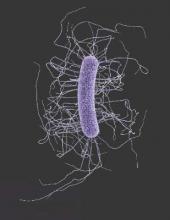The European Society of Clinical Microbiology and Infectious Diseases has updated its clinical guideline for diagnosing Clostridium difficile infection, according to a report in Clinical Microbiology and Infection.
“Our aim is to not only improve diagnosis of C. difficile infection, but also to standardize the diagnostic process across Europe to allow for improved surveillance of the disease,” Ed J. Kuijper, MD, of the Centre for Infectious Diseases, Leiden (the Netherlands) University Medical Centre and lead investigator for the new guideline, said in a press statement.
The Society released its first guideline regarding C. difficile diagnosis in 2009, but it required revision because many new diagnostic tests have become commercially available since then. The updated guideline focuses on diagnosing patients of all ages with diarrhea who are suspected of having C. difficile infection and is intended for use by medical microbiologists, gastroenterologists, infectious disease specialists, and infection control practitioners, said Monique J.T. Crobach, MD, who is also of Leiden University and is first author of the guideline, and her associates (Clin Microbiol Infect. 2016;22:S63-81).
They performed a comprehensive meta-analysis of 56 studies that compared 24 commercially available diagnostic assays against either of the current “gold standard” tests, the cell cytotoxicity neutralization assay or the toxigenic culture. Forty-one of these studies were published after 2009. Based on their findings, Dr. Crobach and her associates formulated 16 recommendations and suggestions, noting the quality of evidence supporting each one.
The updated guideline strongly recommends against using any single diagnostic assay to diagnose C. difficile infection, regardless of the technology on which it is based. Instead, diagnosis should rest on clinical signs and symptoms together with a two-step algorithm starting with either a nucleic acid amplification test or a glutamate dehydrogenase enzyme immunoassay. Samples with positive results on this initial test should be tested further with a toxin A/B enzyme immunoassay.
An alternative algorithm is to initially test samples with both a glutamate dehydrogenase and a toxin A/B enzyme immunoassay. The guideline spells out what actions to take in the event of concordant positive results, concordant negative results, or discordant results.
Testing for C. difficile should not be limited to samples with a specific request from a physician. All unformed stool samples from patients aged 3 years and older should be tested for the organism. In contrast, formed stool samples shouldn’t be tested for C. difficile unless the patient has paralytic ileus.
The guideline also addresses repeat testing. Performing a repeat test after an initial negative result during the same diarrheal episode may be useful in selected cases with ongoing clinical suspicion during an epidemic situation, or even in cases with high clinical suspicion during endemic situations. But repeat testing after an initial positive result generally is not recommended. Repeat testing to assess whether the patient is cured is definitely not recommended.
However, the decision to treat patients for C. difficile infection is a clinical one and may be justified even if all laboratory results are negative, Dr. Crobach and her associates noted.


